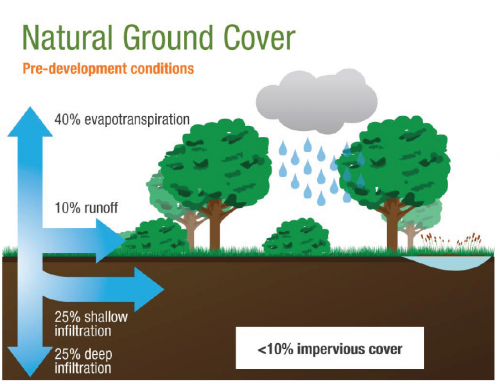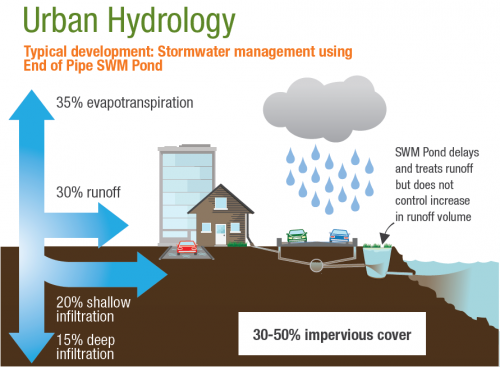Difference between revisions of "Urbanization"
Tvanseters (talk | contribs) |
|||
| Line 27: | Line 27: | ||
There are many reasons that make LID the smart choice when it comes to stormwater management. The creation of well-designed permeable landscapes provides an opportunity to capture, retain and infiltrate stormwater runoff close to its source. Rather than treat stormwater as a waste product to be discarded, LID recognizes stormwater for what it is – a resource to be safeguarded and harnessed for the benefit of both the built and natural environment. | There are many reasons that make LID the smart choice when it comes to stormwater management. The creation of well-designed permeable landscapes provides an opportunity to capture, retain and infiltrate stormwater runoff close to its source. Rather than treat stormwater as a waste product to be discarded, LID recognizes stormwater for what it is – a resource to be safeguarded and harnessed for the benefit of both the built and natural environment. | ||
A central tenet underpinning low impact development approaches to stormwater management is the treatment train approach, which describes a hierarchical suite of practices which manage rainfall where it falls, followed by the attenuation, filtration and infiltration of stormwater along its path of travel and – eventually – using an end-of-pipe detention and polishing process. While many LID practices – including [[bioretention]], soakaway pits and others – are not necessarily intended to remedy issues related to urban flooding per se, they are effective at easing the pressure on aging, overburdened stormwater infrastructure. That being said, there are new options in the LID toolkit which have the capacity to provide both peak flow and large event runoff volume control. | A central tenet underpinning low impact development approaches to stormwater management is the treatment train approach, which describes a hierarchical suite of practices which manage rainfall where it falls, followed by the attenuation, filtration and infiltration of stormwater along its path of travel and – eventually – using an end-of-pipe detention and polishing process. While many LID practices – including [[bioretention]], soakaway pits and others – are not necessarily intended to remedy issues related to urban flooding per se, they are effective at easing the pressure on aging, overburdened stormwater infrastructure. That being said, there are new options in the LID toolkit which have the capacity to provide both peak flow and large event runoff volume control. | ||
| − | + | ||
| + | ==References== | ||
[[category: Background]] | [[category: Background]] | ||
[[category:Planning]] | [[category:Planning]] | ||
Latest revision as of 18:06, 6 October 2022
Pre-development hydrology[edit]
In Ontario prior to development, it is typical for rain falling to the surface to be intercepted by the leaves and stems of vegetation, and this is referred to as interception storage. The amount of rain lost to interception storage depends on the kind of vegetation and its growth stage, but abstraction values of 1 – 4 mm are typical [1].
The presence of vegetation also helps to reduce the incidence of soil crusting which can otherwise occur when raindrops impact bare soil surfaces. The root systems of vegetation help to loosen the soil and increase its connected porosity, and this in turn promotes more rapid infiltration. A landscape’s infiltration capacity is also dependent on soil texture; the highest infiltration capacities are typically found in loose, sandy soils, while heavy clay or clay-loam soils usually have lower infiltration capacities.
If rain falls at rate which is greater than the underlying soils infiltration rate, it will begin to fill depressions, at which point runoff will begin to be generated. The production of runoff is accelerated as surface slope increases and slope lengths decrease, as both considerations increase surface runoff velocities and decrease the time of concentration [2]. Under natural conditions, the presence of surface vegetation and leaf litter provides ample opportunity for rainfall to be intercepted, detained and infiltrated – even in area with moderate to steep slopes.
About 10 % of the annual rainfall amount in such areas is lost as surface runoff. The rest of the water supports the growth of vegetation (40 %), feeds nearby watercourses (20 %) and recharges aquifers (20 %).
Post-development hydrologic changes[edit]
Water quantity changes[edit]
While rainfall intensity, soil and vegetation characteristics, slope length and steepness all play a role in the timing and rate of runoff generation, the creation of impervious surfaces – including rooftops, driveways, roads and parking lots – disrupts rainfall’s ability to penetrate the soil surface and infiltrate. In heavily urbanized, well-drained areas, the time of concentration is significantly reduced due to the relative smoothness of impervious surfaces, and the dense network of stormwater conveyance infrastructure including gutters, catch basins and sewers.
In urban areas which use stormwater ponds to control the peak flow of runoff entering receiving environs the net volume of runoff remains the same, but the rate of release is controlled. In older urban areas where stormwater ponds are not commonly in use, the timing and rate of release of stormwater to the receiving environment is uncontrolled, and this is representative of approximately 85% of existing urban areas throughout Ontario.
The large volumes of stormwater runoff produced under such circumstances over stress conventional stormwater systems leading to flooding, erosion, habitat destruction, degraded water quality, damage to infrastructure systems and post-flooding health-related concerns including mould growth and contaminated drinking water supplies.
Water quality impacts[edit]
Surface runoff generated in urban areas frequently carries with it a cocktail of pollutants. Although it is variable in nature, runoff pollutants are typically derived from a combination of fine sediments from atmospheric deposition, oil, grease and heavy metals (including Cd, Cu, Fe, Ni, Pb, Zn, etc.) from vehicular traffic and industrial activities, nutrients derived from lawn fertilizers and pet waste, and – in seasonally cold climates – road salt from winter maintenance activities [3] [4]. These pollutants accumulate on the road surface during the antecedent dry period between consecutive rainfall events, and are washed off at the onset of rainfall. The majority of particles are washed off with the first flush of stormwater runoff, typically considered to be accounted for with the first 25 mm of runoff [5].
Alleviating pressures using LID[edit]
There are many reasons that make LID the smart choice when it comes to stormwater management. The creation of well-designed permeable landscapes provides an opportunity to capture, retain and infiltrate stormwater runoff close to its source. Rather than treat stormwater as a waste product to be discarded, LID recognizes stormwater for what it is – a resource to be safeguarded and harnessed for the benefit of both the built and natural environment. A central tenet underpinning low impact development approaches to stormwater management is the treatment train approach, which describes a hierarchical suite of practices which manage rainfall where it falls, followed by the attenuation, filtration and infiltration of stormwater along its path of travel and – eventually – using an end-of-pipe detention and polishing process. While many LID practices – including bioretention, soakaway pits and others – are not necessarily intended to remedy issues related to urban flooding per se, they are effective at easing the pressure on aging, overburdened stormwater infrastructure. That being said, there are new options in the LID toolkit which have the capacity to provide both peak flow and large event runoff volume control.
References[edit]
- ↑ United Nations Food and Agricultural Organization (UNFAO). 1991. A Manual for the Design and Construction of Water Harvesting Schemes for Plant Production. Available at URL: http://www.fao.org/docrep/u3160e/u3160e00.htm#Contents
- ↑ Sharma, K.D. 1986. Runoff behaviour of water harvesting microcatchments. Agricultural Water Management 11 (2): 137-144
- ↑ Aryal, R. Vigneswaran, S. Kandasamy, J.; Naidu, R. 2010. Urban Stormwater Quality and Treatment. Korean Journal of Chemical Engineering, 27(5):1343-1359
- ↑ Trenouth, W.R. Gharabaghi, B., Perera, N. 2015. Road salt application planning tool for winter de-icing operations. Journal of Hydrology. 524:401-410
- ↑ Stenstrom, M.K. Kayhanian, M. 2005. First flush phenomenon characterization. Prepared for California Department of Transportation, Division of Environmental Analysis. Available at URL: http://www.dot.ca.gov/hq/env/stormwater/pdf/CTSW-RT-05-073-02-6_First_Flush_Final_9-30-05.pdf


